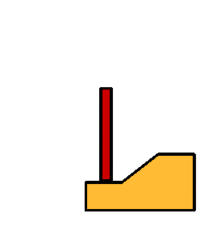Linear Cam: Difference between revisions
From DT Online
mNo edit summary |
m (Added animation) |
||
| Line 1: | Line 1: | ||
[[File: | [[File:Lc.gif|200px|right]] | ||
'''Linear cams''' move backwards and forwards in a '''[[Types of Motion|reciprocating motion]]''' and the shape of the surface of the cam determines how far, and in what manner, the ‘follower’ moves in response. | '''Linear cams''' move backwards and forwards in a '''[[Types of Motion|reciprocating motion]]''' and the shape of the surface of the cam determines how far, and in what manner, the ‘follower’ moves in response. | ||
Most cams are design using a '''[[Displacement Diagram]]''' - essentially a graph which plots the cam movement against the follower movement. A linear cam can be imagined to be the shape of the graph cut from solid plate and then passed backwards and forwards beneath the follower. | Most cams are design using a '''[[Displacement Diagram]]''' - essentially a graph which plots the cam movement against the follower movement. A linear cam can be imagined to be the shape of the graph cut from solid plate and then passed backwards and forwards beneath the follower. | ||
Revision as of 09:38, 19 April 2016
Linear cams move backwards and forwards in a reciprocating motion and the shape of the surface of the cam determines how far, and in what manner, the ‘follower’ moves in response.
Most cams are design using a Displacement Diagram - essentially a graph which plots the cam movement against the follower movement. A linear cam can be imagined to be the shape of the graph cut from solid plate and then passed backwards and forwards beneath the follower.
Note: A simple wedge can be regarded as a basic form of linear cam - when driven into the end of a timber log, or used as an axe, the wedge transfers the vertical linear motion of the hammer into a horizontal force which spilts the wood.
